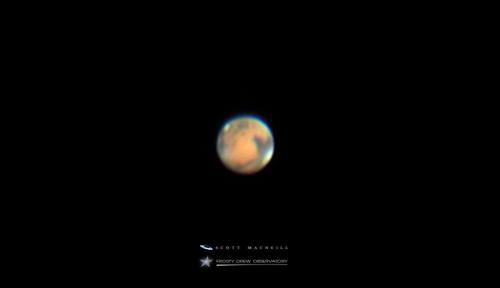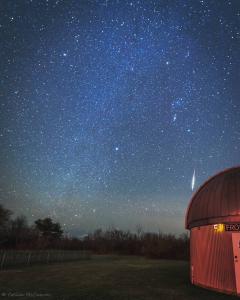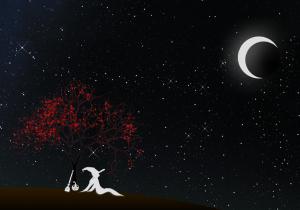Celebration of Space - October 9, 2020
This past Tuesday, October 6, 2020, Earth made its closest approach to Mars for Mars’ 687 day orbital period, at a distance of 38.6 million miles. Usually, this happens during opposition of an outer planet, though with Mars, this is not always the case. Mars has a rather elliptical orbit compared to Earth’s orbit, which results in a rather dramatic difference between Mars’ perihelion (closest to the Sun) and aphelion (furthest from the Sun). Depending on where Mars is in its orbit, during the opposition period, Earth can make its closest approach to Mars within a few weeks of the date of opposition. Opposition for 2020 will occur on October 13th, which is when Mars will be on the opposite side of Earth than the Sun. On that night Mars will rise with the setting Sun, and set with the rising Sun. After opposition, Mars will be above the horizon at sunset. Best viewing of Mars is about 2 months centered on the opposition date, with the best views happening during the weeks around opposition. Considering that Mars’ orbital period (687 days) is almost twice the duration of Earth’s (365 days) , Mars’ opposition happens once every 2 years. Now is the time to get out and see Mars, and Frosty Drew Observatory will be rocking the views over the next several weeks. So stop in and see it for yourself.
Now that we are well into autumn in the Northern Hemisphere, meteor shower season it reaching its peak. On a yearly basis, we see meteor shower activity start picking up in April, with the Lyrid Meteor Shower. Over the summer, meteor shower activity continues to increase, and we see one of the most active showers in August – the Perseid Meteor Shower. Starting in mid-autumn, we end up in a period with several notable meteor showers happening in overlapping order. From September 10th – November 20th, the Southern Taurid Meteor Shower occurs, bringing numerous fireball meteors, and will peak overnight October 29-30. From October 2nd – November 7th, the annual Orionid Meteor Shower occurs, with the peak happening overnight October 20-21. From October 20th – December 10th, the Northern Taurid Meteor Shower occurs, also bringing numerous fireball meteors, with a peak date set overnight November 11-12. From November 6th – November 30th, the annual Leonid Meteor Shower occurs, with the peak happening overnight November 16-17. All of these showers, individually, are not all that amazing. But since there is a lot of overlap, we see a large increase in regular meteor activity. The Taurid showers are especially notable because of the increase in fireball meteor activity. A fireball meteor is a shooting star that is significantly brighter and longer lasting than a regular meteor. Fireball meteors often fragment as they pass, and sometimes will span the entire sky. At Frosty Drew we have seen Taurid fireballs light up the ground, fragment, and fracture; and we have seen all of this already this year! Though the best meteor shower to come is the December Geminid Meteor Shower, which peaks overnight on December 13-14, 2020. This is, hands down, the best meteor shower of the year! Considering that we will have nearly a New Moon on that night, all we need is a cloud free sky, and the shower will rock socks! Whether you’re a seasoned meteor shower photographer, or just a budding meteor watcher, now is the time to gear up and get out, because fabulous shooting star activity is already happening.
Save the Date!
Friday, October 30, 2020
Spooky Views – A Halloween Stargazing Experience
On the Friday before Halloween, Frosty Drew Observatory geeks out in full on Halloween creepiness. We deck the Observatory with creepy Halloween garb, and tell scary stories about the history or our facilities, before they were inducted into astronomical awesomeness. We observe transitional white dwarf stars, which are the stellar remnants of stars that have died. We have loads of candy and creepy décor, and recommend, but not requite, that visitors dress up in in Halloween garb to celebrate the season. It’s still too early to tell how the event will play out with the global pandemic, but the event is going forward, regardless. So put the date on your calendar, and get your costume in order for a creep, seasonally festive night at Frosty Drew Observatory. If you dare....
- Author:
- Scott MacNeill
- Entry Date:
- Oct 9, 2020
- Published Under:
- Scott MacNeill's Columns




